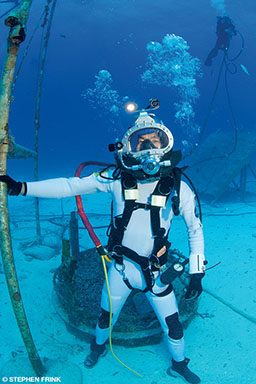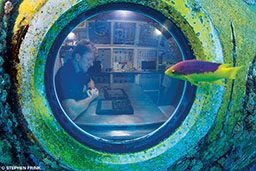People often want to know how deep divers can go. The answer depends on how long they want to spend returning to the surface. For saturation divers, this can be several days or even a week or more.
Saturation (sat) diving is when the inert gas breathed by a diver dissolves into the body’s tissues and reaches equilibrium with the ambient pressure at the diver’s depth (i.e., no more gas can be absorbed by the tissues — they’re fully saturated). This is Henry’s law, named for British chemist William Henry. Tissues saturate at various speeds, but most will be saturated in 24 hours.
Recreational divers limit their time at depth to avoid becoming saturated so they can make a direct ascent to the surface without any mandatory stops. Upon surfacing, they’re supersaturated, meaning the amount of inert gas in the body is greater than the amount found in the surrounding atmosphere. Nature likes balance. The inert gas comes out of the tissues and into the blood, which circulates to the lungs, where the diver exhales it. A technical diver who makes a dive beyond recreational limits must make decompression stops to avoid overburdening the body’s ability to offgas. For saturation divers, these stops can take a week.
So how deep can we dive? In 1992 Comex, a French diving company, conducted a series of experimental dives to 2,133 feet (650 meters) of seawater in a hyperbaric research chamber in France. For two hours one diver went to 2,300 feet (701 meters), which is the deepest a human has gone under pressure (71.1 atmospheres) to date.

Saturation Operations
Today, most sat diving is conducted between 65 feet and 1,000 feet. Decompression from these depths takes approximately one day per 100 feet of seawater plus a day. A dive to 650 feet would take approximately eight days of decompression. With so much decompression time needed to return to the surface, it is more cost effective to keep the divers at depth. Once saturated to a depth, the decompression time is the same regardless of whether the dive lasted one day or 15 days. Most international standards are based on a maximum of 28 days “seal to seal” — the time from entering the chamber to leaving it. This means the working time will depend on how long decompression will take. For example, the dive to 650 feet would give divers a day to descend and rest, 19 days to work and eight days for decompression.
When most people envision saturation diving, they imagine the diver living in a vast undersea complex on the seafloor. There are some such saturation complexes, but commercial sat divers live on board dive support vessels (DSVs) in hyperbaric living quarters. Food and supplies are delivered through small airlocks, and these chambers have areas for sleeping, eating and showering. They even have a hyperbaric life raft should the sat divers have to abandon ship.
Gas
These onboard chambers are pressurized to the depth at the seafloor where the divers are working. This pressure, known as “storage depth,” is typically too deep to dive using air, so the divers breathe a mix of helium and oxygen called heliox. Below 500 feet, heliox can cause high-pressure nervous syndrome (HPNS), which is characterized by tremors. To combat this, a small amount of nitrogen is included in the breathing mix. Its narcotic effect at depth helps reduce the tremors.
The high helium content presents a few challenges. Anyone who has inhaled the gas from a helium balloon knows it makes you sound like a cartoon chipmunk. In a hyperbaric chamber, your voice also changes because of increased air density, and the combination of helium and increased density make for voices that are really hard to understand. Thus, saturation diving operations use voice descramblers so divers can be understood.
Helium is a tiny molecule with poor thermal properties, which means it is easy to breathe but strips heat from the diver with every exhalation. Because of this, the temperature of the living quarters must be kept high to prevent hypothermia. Temperatures can be in the range of 85°F–93°F, depending on depth. When the divers are in the water working, they wear hot-water suits, which are similar to wetsuits but have tubes with hot water continuously running through them to keep the divers warm.
Living Under Pressure

Other considerations that must be taken into account in the sat chamber include infection prevention and diver health. Saturation divers are as isolated as astronauts living on the space station, so they must be medically trained to deal with any emergency that may occur. They are typically trained as diver medical technicians (DMTs). During this course, the commercial diver learns how to insert IV catheters, suture wounds and even deal with life-threatening conditions such as tension pneumothoraces that require pleurocentesis — the release of trapped air from the pleural lining of the lungs.
A typical working day involves 16 hours of rest and sleep in the living quarters and eight hours of diving, in what are known as bell runs. A diving bell is locked onto the chamber, and the pressure is matched. The diver then transfers under pressure (TUP) from the chamber to the bell. The bell is locked out and then lowered by umbilical to the seafloor, where the moon pool, a hatch at the bottom of the bell, can be opened for the divers to exit. Their breathing gas is supplied via hoses from the surface. The gear involved is much the same as the gear used for commercial diving inshore, except that it captures the expired gas for reclamation and recompression of the helium.
Support
From the ship’s crew who operate the vessel to the cooks who prepare the meals that are locked into the divers’ hyperbaric living quarters, it takes a large team to support the divers. A life support technician (LST) and assistant LST are responsible for “sat control,” which involves monitoring the chamber’s temperature, gas content and operational status. They even monitor the function of such things as the toilet, which dumps outside of the chamber. When the divers leave the living quarters to enter the bell for work, another team, called dive control, takes over and runs the dive from the surface. They prepare the bell, launch it and monitor the divers as they work. The ship uses a sophisticated system called dynamic positioning, in which thrusters maintain the ship’s precise position over the work site. This allows the bell to be lowered directly adjacent to the pipeline, for example, and remain in the same position.
Tunnel Work
In addition to its use in deep-sea work, saturation diving is also used in tunneling and caisson work. When building deep, long tunnels, compressed air is used to pressurize the tunnel to maintain the walls and keep out water. When the ambient pressure at the site of the work is greater than 2 atmospheres, the workers travel to the cutting head of the tunnel-boring machine through a series of hyperbaric chambers. They remain under pressure in a saturation system to get the job done.
Science

Scientists also do work using underwater habitats. Living underwater began in the early 1960s with the U.S. Navy’s Sealab I, II and III. The primary mission of these habitats was to study humans’ physiological responses to saturation. Navy divers lived underwater for weeks, while physiologists studied them from the surface. In 1969 scientists went into the underwater habitats for the first time themselves, and the term ”aquanaut” was coined. Working for NASA and the Office of Naval Research, these scientists spent 58 days underwater. In the 1970s, Sylvia Earle, Ph.D., led an all-female team of scientists and engineers on a saturation expedition using the Tektite II habitat.
Scientists continue to conduct missions at the only underwater research facility in operation today, Aquarius Reef Base, which lies off the Florida Keys in a little more than 60 feet of seawater. Its focus has shifted since the 1960s from research in support of deep-sea exploration to research in support of space missions. Each year a team of aquanauts and astronauts spend up to three weeks completing tasks to prepare for space exploration and scientific investigations. NASA Extreme Environment Mission Operations (NEEMO) is now in its 16th year of operation, and the NEEMO XXII mission ended June 27, 2017. The similarities between deep-sea dwelling and living in space are numerous: Both Aquarius and the International Space Station are isolated, and going on excursions from either place requires specialized life-support equipment. The buoyancy of the water allows NASA to weight the NEEMO astronauts to simulate the gravity on an asteroid, planet or moon. Many of the operations that are practiced underwater are later completed during space walks.
If the idea of living underwater like an aquanaut appeals to you, an old research habitat in the Florida Keys was converted into the Jules’ Undersea Lodge. You can scuba dive down into the habitat to spend a night, and the lodge is shallow enough that you won’t have to do days of decompression (or any decompression) or need to spend a week in a hyperbaric chamber when you return to the surface the next day.
Explore More
| © Alert Diver — Q3 2017 |